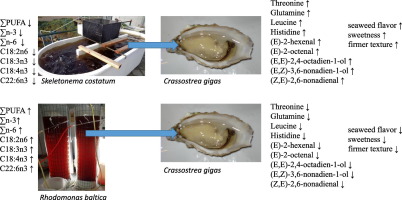当前位置:
X-MOL 学术
›
Food Res. Int.
›
论文详情
Our official English website, www.x-mol.net, welcomes your
feedback! (Note: you will need to create a separate account there.)
The effect of algae diets (Skeletonema costatum and Rhodomonas baltica) on the biochemical composition and sensory characteristics of Pacific cupped oysters (Crassostrea gigas) during land-based refinement
Food Research International ( IF 7.0 ) Pub Date : 2017-06-20 , DOI: 10.1016/j.foodres.2017.06.041 Jasper van Houcke , Isabel Medina , Hanne K. Maehre , Josiane Cornet , Mireille Cardinal , Jozef Linssen , Joop Luten
Food Research International ( IF 7.0 ) Pub Date : 2017-06-20 , DOI: 10.1016/j.foodres.2017.06.041 Jasper van Houcke , Isabel Medina , Hanne K. Maehre , Josiane Cornet , Mireille Cardinal , Jozef Linssen , Joop Luten

|
Oyster refinement, a common practice in France, is aimed at increasing the weight of oyster tissue and influencing the taste properties of the refined oysters. Refinement usually takes place in land-based systems where the oysters are fed with relatively high concentrations of microalgae. In this study the impact of feeding Skeletonema costatum and Rhodomonas baltica on the biochemical composition and sensory characteristics of Pacific cupped oysters (Crassostrea gigas) from the Eastern Scheldt during land-based refinement was studied.After a feeding period of four and seven weeks market-sized oysters were sampled for the analysis of fatty acids, free amino acids and volatile organic compounds and for a sensory evaluation by consumers and an expert panel.The algae Skeletonema costatum showed a lower ∑ PUFA, ∑ n − 3, ∑ n − 6, C18:2n6, C18:3n3, C18:4n3, C22:6n3 content as compared with Rhodomonas baltica. These differences were also reflected in the fatty acid profile of the oysters fed with the corresponding algae diets. Furthermore, general linear model and principal component analysis showed marked differences in free amino acids and volatile organic compound content between Skeletonema, Rhodomonas fed oysters and reference oysters. For example, threonine, glutamine, leucine, histidine, (E)-2-hexenal, (E)-2octenal, (E)-2-octen-1-ol, (E,E)-2,4-octadien-1-ol, (E,Z)-3,6-nonadien-1-ol and (Z,E)-2,6-nonadienal contents were higher in Skeletonema fed oysters compared to Rhodomonas fed oysters. Sensory differences between the experimental oyster groups were shown. Skeletonema fed Pacific cupped oysters were characterized by a stronger seaweed flavor, higher perceived sweetness and a firmer texture in comparison with Rhodomonas fed oysters. Naïve consumers were only able to differentiate between Rhodomonas fed oysters and reference oysters.
中文翻译:

日粮藻类饮食(Skeletonema costatum和Baldo Rhodomonas baltica)对陆生精制太平洋杯牡蛎(Crassostrea gigas)的生化组成和感官特征的影响。
牡蛎精炼是法国的一种常见做法,目的是增加牡蛎组织的重量并影响精炼牡蛎的口感。精炼通常在陆基系统中进行,在该系统中,牡蛎被喂食了相对较高浓度的微藻。在这项研究中,研究了陆生动物精制过程中饲喂肋骨油菜和波罗的海红球藻对东部谢尔德特太平洋杯牡蛎(Crassostrea gigas)的生化组成和感官特性的影响。经过四周和七周的摄食期后,对市场规模的牡蛎进行采样,以分析脂肪酸,游离氨基酸和挥发性有机化合物,并由消费者和专家小组进行感官评估。藻类中肋骨条藻显示较低的Σ PUFA,Σ Ñ - 3,Σ Ñ - 6,C18:2N6,C18:3n3,C18:4N3,C22:6N3含量相比,Rhodomonas波罗。这些差异也反映在饲喂相应藻类饮食的牡蛎的脂肪酸谱中。在游离氨基酸和之间的挥发性有机化合物含量。此外,一般线性模型和主成分分析表明显着差异中肋骨, 红景天饲喂牡蛎和参比牡蛎。例如苏氨酸,谷氨酰胺,亮氨酸,组氨酸,(E)-2-己烯醛,(E)-2辛烯醛,(E)-2-辛烯-1-醇,(E,E)-2,4-辛二烯-1骨架牡蛎牡蛎中-ol,(E,Z)-3,6-壬二烯-1-ol和(Z,E)-2,6-壬二烯醛含量高于红景天牡蛎。显示了实验牡蛎组之间的感官差异。与以红球藻喂养的牡蛎相比,以骨骼为食的太平洋杯形牡蛎的特征在于具有更强的海藻风味,更高的感知甜度和更坚硬的质地。幼稚的消费者仅能区分喂食红球菌的牡蛎和参考牡蛎。
更新日期:2017-09-04
中文翻译:

日粮藻类饮食(Skeletonema costatum和Baldo Rhodomonas baltica)对陆生精制太平洋杯牡蛎(Crassostrea gigas)的生化组成和感官特征的影响。
牡蛎精炼是法国的一种常见做法,目的是增加牡蛎组织的重量并影响精炼牡蛎的口感。精炼通常在陆基系统中进行,在该系统中,牡蛎被喂食了相对较高浓度的微藻。在这项研究中,研究了陆生动物精制过程中饲喂肋骨油菜和波罗的海红球藻对东部谢尔德特太平洋杯牡蛎(Crassostrea gigas)的生化组成和感官特性的影响。经过四周和七周的摄食期后,对市场规模的牡蛎进行采样,以分析脂肪酸,游离氨基酸和挥发性有机化合物,并由消费者和专家小组进行感官评估。藻类中肋骨条藻显示较低的Σ PUFA,Σ Ñ - 3,Σ Ñ - 6,C18:2N6,C18:3n3,C18:4N3,C22:6N3含量相比,Rhodomonas波罗。这些差异也反映在饲喂相应藻类饮食的牡蛎的脂肪酸谱中。在游离氨基酸和之间的挥发性有机化合物含量。此外,一般线性模型和主成分分析表明显着差异中肋骨, 红景天饲喂牡蛎和参比牡蛎。例如苏氨酸,谷氨酰胺,亮氨酸,组氨酸,(E)-2-己烯醛,(E)-2辛烯醛,(E)-2-辛烯-1-醇,(E,E)-2,4-辛二烯-1骨架牡蛎牡蛎中-ol,(E,Z)-3,6-壬二烯-1-ol和(Z,E)-2,6-壬二烯醛含量高于红景天牡蛎。显示了实验牡蛎组之间的感官差异。与以红球藻喂养的牡蛎相比,以骨骼为食的太平洋杯形牡蛎的特征在于具有更强的海藻风味,更高的感知甜度和更坚硬的质地。幼稚的消费者仅能区分喂食红球菌的牡蛎和参考牡蛎。













































 京公网安备 11010802027423号
京公网安备 11010802027423号